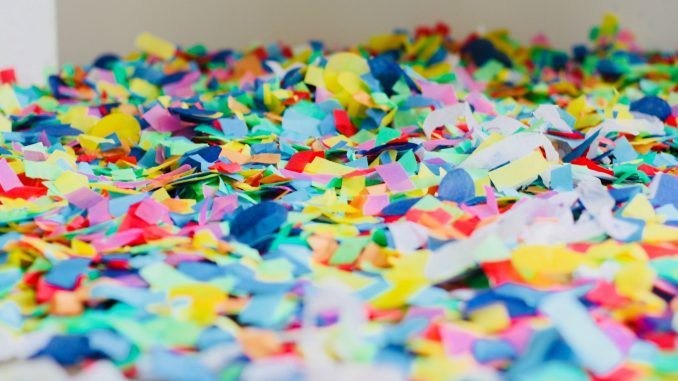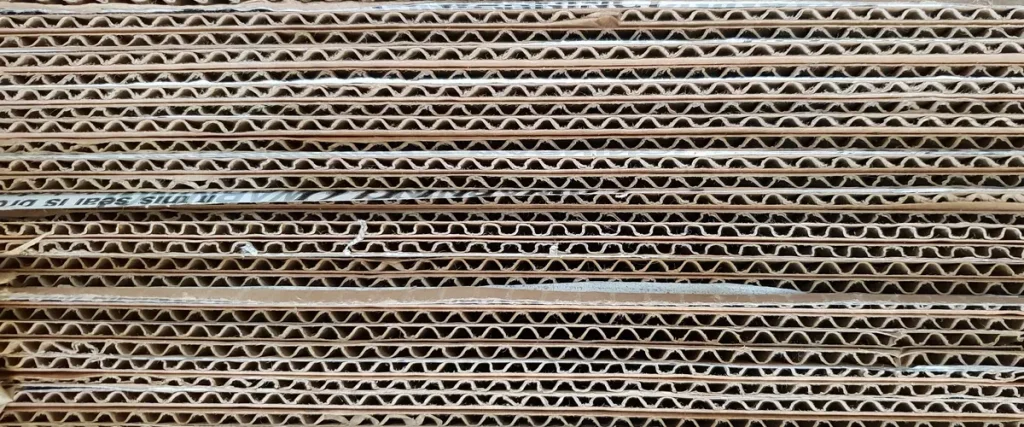
Composting cardboard, newspaper, and junk mail can speed up composting, relieve pressure on the recycling industry, eliminate stinky compost problems, fight climate change, and earn you some serious eco-friendly karma points.
At Recycled & Renewed, we love recycling but we also love composting. Whereas 60-70% of paper and cardboard gets recycled (a pretty high number relative to other materials), I know for a fact that 100% of the paper I put in my compost stays out of a landfill (more on the environmental pros and cons below).
Help! My Compost Smells Like Poop
Do you know that the optimal ratio of “brown” (carbon rich) to “green” (nitrogen rich) materials for your compost bin is 30 to 1? That is by WEIGHT!
That means you have to balance all those heavy pails of vegetable scraps with 30 times more shredded paper, cardboard, sawdust, or something similar.
The first signs you’ll likely notice if you have too much green, nitrogen rich materials is a chemical smell, specifically the smell of ammonia wafting up from your compost bin. Your bin is now out of balance and you’ll need to add more brown, carbon rich materials.
If you ignore the ammonia smell, you might end up with the dreaded stinky, slimy, disgusting compost.
Where Do I Get Carbon Sources For My Compost?
If you happen to be a carpenter with ready access to an unlimited source of sawdust or you live on a farm with piles of straw sitting around, you can stop reading here. Otherwise, where the heck do you get 30 times more carbon rich materials for your compost?
The most practical option is the constant stream of pointless mailings shoved into your mailbox, the piles of Amazon boxes clogging up your recycling bin, or that Sunday newspaper that you are too busy to read.
Paper is super rich in carbon, weighing in at a 200 to 1 ratio of carbon to nitrogen. But the heavy weight is cardboard, coming in at a hefty 560 to 1 ratio.
Another option is paper towels, which are also compostable.
Finally, there are leaves in the fall. But you need to shred them first or you get an anaerobic compost pile once those big ole’ leaves get a little wet. They will mat down your pile as if you threw a heavy wet blanket on that rocking microorganism party in your bin – don’t be a wet blanket and ruin the party.
But how do you shred a bunch of dirty leaves? I’m sure there are ways, but are they practical? I think not.
You are better off creating a leaf mold pile, basically the easiest way to start composting and the fastest way to a nice supplement for your garden. And instead, start composting cardboard, old newspaper, and unwanted junk mail to balance all those veggies in your compost bin.
Composting Cardboard and Junk Mail With A Shredder
You basically have two choices for composting cardboard, newspaper, and junk mail. We recommend buying a shredder. The other, much more time-consuming option is to rip it up by hand.
Things to consider when choosing a shredder:
- You need a micro-cut shredder. Crosscut shredders, which makes little strips of paper, will get matted down when wet and cause problems in your compost pile, just like wet leaves.
- Try to max out on the number of pages you can shred at once without breaking the bank (large capacity shredders are really expensive)
The micro-cut shredder we recommend balances maxing out capacity (12 pages at a time) so you can shred up boxes for composting cardboard but at a reasonable price.
RECOMMENDED SHREDDER: AMAZONBASICS 12 SHEET MICRO-CUT SHREDDER

For years we ripped up paper and thin cardboard by hand. Not a bad workout if you want to build hand strength and have nice muscular hands (I’m kidding, unless you are a hand model), but this is so much faster and easier.
Also, it has really supercharged the breakdown cycle of our compost pile. If your house is anything like ours, you have plenty of “greens” (food scraps and such) but less “browns” for your compost. The shredder approach really keeps your compost pile more balanced.
Can You Shred Cardboard in a Wood Chipper
Another option to consider if you want to get real intense is to use a wood chipper. The benefit here is you can increase your carbon to nitrogen ratio significantly by shredding up sticks and branches.
Amazon has an electric-powered chipper and a gasoline-powered version. If you want to tackle larger branches, go with the gas-powered option. Otherwise, we recommend the electric version to reduce your emissions as well as to avoid dealing with smelly, messy gas canisters.
One note, we have not tested these chippers. Most households can get away with a simple paper shredder for most of their composting cardboard needs.
Composting Cardboard, How Do I Start?
Well, obviously you’ll need a compost bin (read our comparison of composting tumblers vs. bins here). Next you need a shredder with large capacity. The reason you want to max out on the number of pages you can shred when you buy a shredder is the larger capacity shredders are good for composting cardboard. Larger capacity shredders have larger “mouths” that can fit pieces of cardboard.

You will need to also buy some oil (here is a link to the kind we bought from Amazon) and use it frequently for composting cardboard. Shredding thick corrugated cardboard boxes continuously could wear your shredder out.
Based on our experience, I recommend shredding thinner cardboard to add to your compost pile and keep the thicker cardboard mostly to the recycling bin (I think occasional thick cardboard is fine, but boxes upon boxes might be too much for your shredder).
Can You Compost Paper With Ink?
Based on our research, there are some precautions to take when composting your junk mail, cardboard, and other paper with printing on it.
However, junk mail printed on regular office paper is fine for composting. All those bank statements, credit card statements, charity solicitations, etc., you can shred and add them to your compost.
Newspapers are fine since they are now generally printed with soy-based inks.
Compost vs. Landfill – What is Better For The Earth?
This is a tricky question but let’s get some of the less convoluted versions of this question out of the way.
When it comes to paper that you are going to shred anyway – bank statements, credit card statements, anything with sensitive information – composting it is best. Most recycling programs do not accept shredded paper.
Shredding paper actually degrades its integrity, making it harder to recycle. A micro-cut shredder like the one we recommend makes the paper even less suitable for recycling.

Now what about diverting recyclable paper from the recycling stream and into your compost? This question is less clear.
The Case For Recycling Paper
On the recycling side of the argument, recycling paper definitely saves energy, saves water, and reduces greenhouse emissions. Recycling one ton of paper saves enough energy to power the average home for six months and saves 7,000 gallons of water (that would fill up a 50 gallon rain barrel every day for around five months!)
When paper is placed in landfills, it produces methane, a highly potent greenhouse gas up to 34 times more powerful than carbon dioxide.

According to the EPA, paper is the largest (in terms of weight but excluding steel) type of material being recycled in the US. In terms of the percent of paper that actually gets recycled, it is relatively high (when compared to other materials like plastic). Sixty to seventy percent of paper entering the recycling stream is recycled.
The Case For Composting Cardboard, Junk Mail, And Newspaper
However, as obvious from the percentage above, on average 40% of the paper you place in your recycling bin is not recycled.
There is one thing you can be sure of when you shred your junk mail, cardboard, and newspaper and stick it in your compost – it is not going to a landfill.
In fact, it is not getting put on a pollution-spewing truck and driven dozens of miles, it isn’t getting dumped into a big pile and pushed around by large machines, driven up conveyor belts, sorted by large machines…I think you get the point. Composting the paper avoids all that processing energy.
Though demand for recycled paper fiber exceeds supply, according to the Sustainable Packaging Coalition, it is not because of lack of material. It is actually constrained by the number of mills available to process the recycled material.
The bottom-line is diverting a portion of your recyclable paper to the compost is unlikely to negatively impact the recycling industry. If anything, putting my amateur economist hat on, constraining the supply a bit would potentially mean the balance between demand and supply would get even further unbalanced. Maybe demand would spur more investment in plants that can process a higher percentage of existing recycled material supply?
Either way, a few boxes or pounds of paper diverted to your compost bin probably won’t cause the paper recycling industry to capsize.
APPENDIX – Kudos to Amazon for the (Nearly) Zero Waste Packaging
I wanted to note that Amazon, probably not the most sustainable company in the world, did a good job with this shredder. Here at R&R we have a pet-peeve about unnecessary packaging waste, especially plastic waste.
This unit came with almost zero plastic (the tape on the box may have had minimal plastic in it) and was fully recyclable or compostable. It was basically a cardboard box with two cardboard inserts, pictured below. Good job Jeff Bezos, more of that approach would be very much appreciated here!

Here at R&R we only endorse products we have owned, tested, and fell in love with. If you end up making a purchase through one of our affiliate links, we may earn a very small commission that offsets the cost of hosting, building, and maintaining this site. We encourage purchasing products directly from companies since many of the ones we highlight are small businesses. When possible, we provide the link to the company website and Amazon to provide that option for you.